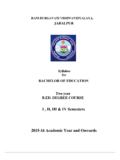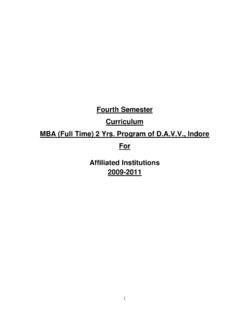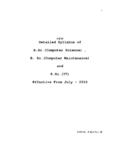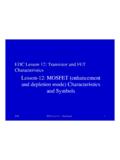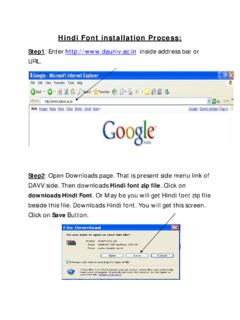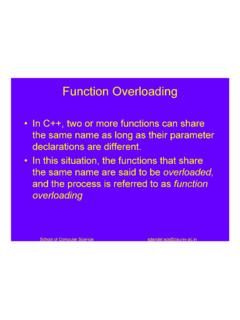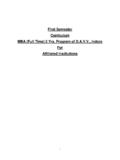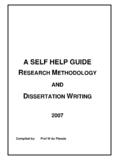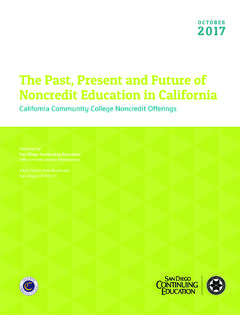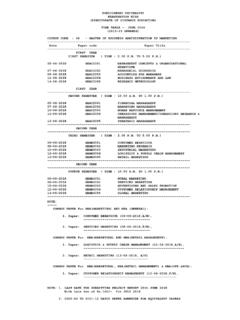Transcription of LEGAL EDUCATION AND RESEARCH METHODOLOGY
1 DET- 2014. Law Syllabus LEGAL EDUCATION AND RESEARCH METHODOLOGY . Syllabus 1. Objectives of LEGAL EDUCATION Lecture Method of Teaching Merits and demerits The Problem Method Discussion method and its suitability at postgraduate level teaching The Seminar method of teaching Examination system and problems in evaluation-external and internal assessment. Student participation in law school programs - Organization of seminars, publication of journal and assessment of teachers. Clinical LEGAL EDUCATION - LEGAL aid, LEGAL literacy, LEGAL survey and law reform. 2. RESEARCH Methods Social LEGAL RESEARCH Doctrinal and non doctrinal relevance of empirical RESEARCH Induction and deduction 3.
2 Identification of Problem of RESEARCH What is a RESEARCH problem? Survey of available literature and bibliographical RESEARCH . Legislative materials including subordinate legislation, notification and policy statements. Decisional material including foreign decisions, method of discovering the rule of the case tracing the history of important case and ensuring that these have not been over-ruled, discovering judicial conflict in the area pertaining to the RESEARCH problem and the reason thereof. Juristic writings a survey of juristic literature relevant to select problems in India and Foreign periodicals.
3 4 Perparation of the RESEARCH design Formulation of the RESEARCH Devising tools and techniques for collection of date METHODOLOGY Methods for the collection of statutory and case materials and juristic literature. Use of historical and comparative materials. Use of observation studies. Use of questionnaires/interview Use of case studies. Sampling procedures design of sample, types of sampling to be adopted. Use of scaling techniques. Jurimetrics. Computerized RESEARCH - A study of LEGAL RESEARCH programmers such as Lexis and West law coding. Classification and tabulation of data use of cards for data collection Rules for tabulation.
4 Explanation of tabulated data . Analysis of data Compilation of list of reports or special studies Conducted relevant to the problem. BIBLIOGRAPHY. 1. Brayal, Nigel Dunean and Richard Crimes, Clinical LEGAL EDUCATION Active Learning in your School,(1998)Blackstone press Limited ,London. 2. Agrawal (Ed.), LEGAL EDUCATION in India (1973),Tripathi,Bombay. 3. Madhava Menon,EEd. A Handbook of Clinical LEGAL EDUCATION , (1998) Eastern Book Company, now. 4. Price, and Bysiewiwz,Effective LEGAL RESEARCH (1978). 5. The ,Scientific Social Survey and RESEARCH (1962). 6. Jam and Paul K. Hatt,Methods in School RESEARCH , Mc Graw-Hill Book Company Ion.
5 7. Hyman,Interviewing in Social RESEARCH (1965). 8. Ne, The are of Asking Question (1965). 9. In , and , A Guide to LEGAL RESEARCH (1959). L. Cohan, LEGAL RESEARCH in Nutshell ,(1996),west publishing Co. 11. Yard Law Review Association,Uniform System of citations. 12. Publication, LEGAL RESEARCH and METHODOLOGY .. LAW AND SOCIAL TRANSFORMATION IN INDIA. Syllabus 1. Law and social change Law as an instrument of social change. Law as the product of traditions and culture. Criticism and evaluation in the light of colonization and the introduction of common law system and institute in India and its impact on further development of law and LEGAL institution in India.
6 2. Religion and the law Religion as a divisive factor Secularism as a solution to the problem Reform of the law on secular lines: Problems Freedom of religion and non discrimination on the basis of religion Religious minorities and the law. 3. Language and the law Language as a divisive factor: formation of linguistic states Constitutional guarantees to linguistic minorities Language policy and the Constitution: Official language;. multi-language system Non-discrimination on the ground of language. 4. Community and the law Caste as a divisive factor Non-discrimination on the ground of caste Acceptance of caste as a factor to undo past injustices Protective discrimination: Scheduled castes, tribes and backward classes Reservation statutory Commissions and Statutory provisions 5.
7 Regionalism and the law Regionalism as a divisive factor Concept of India as one unit Right of movement, residence and business; impermissibility of state or regional barriers. Equality in matter of employment: The slogan sons of the soil . and its practice. Admission to educational institutions: preference to residents of a state. 6 Women and the law Crimes against women. Gender injustice and its various form. Women's Commission. Empowerment of Women: Constitutional and other LEGAL provisions. 7. Children and the law Child labor Sexual exploitation. Adoption and related problems. Children and EDUCATION .
8 8 . Modernisation and the law Modernisation as a value: Constitutional perspectives reflected in the fundamental duties. Modernisation of social institutions through law Reform of family law Agrarian reform-Industrialisation of agriculture Industrial reform: Free enterprise Vs. State regulation, Industrialisation Vs. environmental protection. Reform of court processes . Criminal law: Plea of bargaining: compounding and payment of compensation to victims. Civil law(ADR) Confrontation v. consensus; mediation and conciliation; Lok adalats Prison reforms Democratic decentralization and local self-government 9.
9 Alternative approaches to law The jurisprudence of Sarvodaya Gandhiji, Vinoba Bhave;. Jayaprakash Narayan Surrender of dacoits;concept of grama Nyayalaya. Socialist thought on law and justice: An enquiry through Constitutional debates on the right to property. Indian Marxist critique of law and justice. Naxalite movement :causes and cure. Select Bibliography Marc Galanter (ed) Law and society in Modern India (1997) Oxford. Robert Lingat,The Classical Law of India(1998) Oxford. ,The Crisis of the Indian LEGAL System(1982)Vikas,New Delhi. Cod.),Law and Poverty Critical Essays (1988).Tripathi,Bombay.
10 Manushi ,A Journal About Women and Society. Duncan Derret,-The Slate ,Religion and Law in India(1999)- Oxford University press,New Delhi. , Constitutional Law of India (1996),Tripathi. Shorter Constitution of India (1996),Prentice-Hall of India (P) Ltd,New Delhi. Sunil Deshta and Kiran Deshta,Law and Menace of Child Labour (2000). Armol Publications,Dehli. Savitri Gunasekhare,Childern,Law and Justice(1997),sage. Indian Law institute,Law and Social Change:Indo-American Reflections, Tripathi (1988). ,Gandhi:His Life and Thought, (1970)Ministry of Information and Broadcasting,Government of India.
